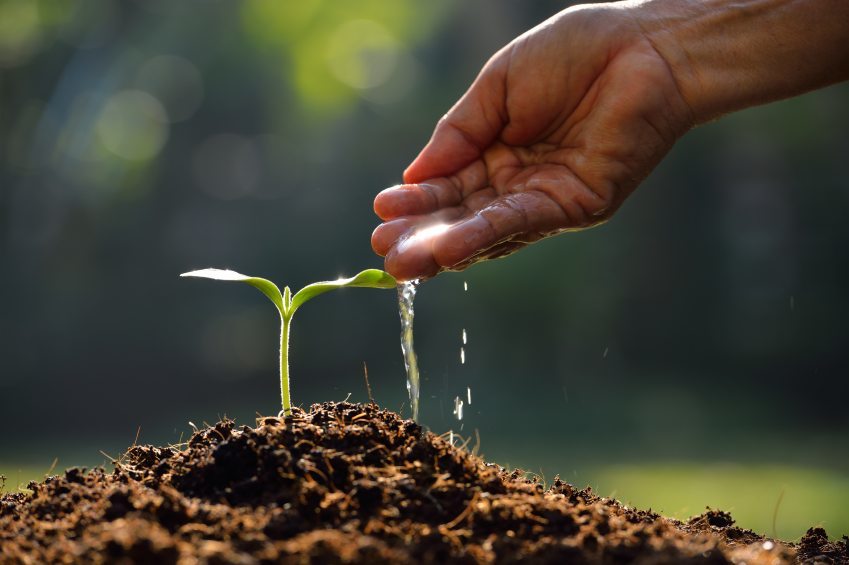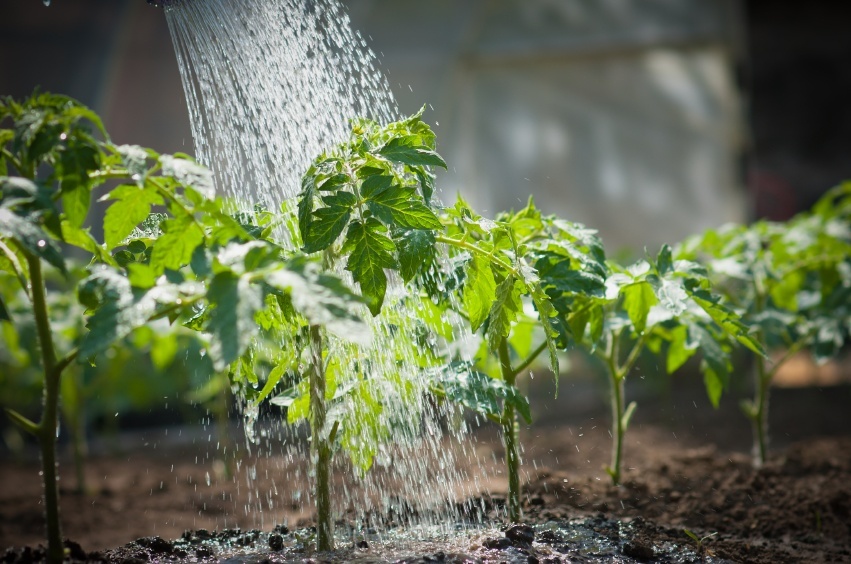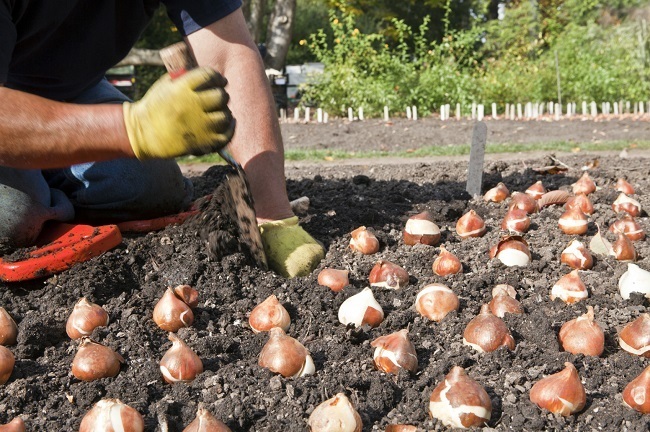We gardeners seem to prefer learning the hard way. In spite of all the gardening books we browse through, and the classes we attend, mistakes are invariably made. Here’s a sample of the ones many have made and regretted.
Not preparing the beds
Most of us have made this mistake, some out of ignorance, and others due to sheer laziness. When the little seeds and seedling go into the damp earth in spring, it seems the tiny planting holes we make with our fingers or a small hand shovel are room enough for them. But the soil soon dries out and becomes rock hard. If the roots of the young plants cannot penetrate into the soil, you’ll end up with stunted plants.
Digging and double digging the garden beds and adding in plenty of compost and leaf mold makes the soil loose enough for good root run. And this backbreaking work has to be done before you plant things. Making raised beds is another option if you don’t want to dig deep.
Leaving out soil amendment
We tend to forget that soil is like a living organism, always changing and evolving. Soil conditions can fluctuate with the amount of rainfall, soil runoff and lack of drainage. Some plants deplete certain soil nutrients more than the others. Heavy rains can leach away the limestone you recently added to raise the pH of your broccoli bed.
It pays to check the soil for pH level and mineral profile every growing season and make necessary amendments a few weeks before planting time. Then test again to make sure things are perfect for the plants that are getting ready to go in.
Organic matter has a modulating effect on soil chemistry, so the more humus your soil has, the lesser the chemical fluctuations. Add plenty of compost and cured manure to your vegetable beds. Good soil is particularly important for your veggies garden since you need healthy plants that produce high-quality food.
Overwatering
Overwatering is like killing with too much love. Most over enthusiastic gardeners are guilty of this crime. Frequent watering may be necessary until seedlings and cuttings get established. But once they have developed a good root system, water them at regular intervals.
The roots of most plants hate sitting in water. Like every other plant tissue, roots need to breathe. They literally drown if all the air pockets in the soil are filled with water all the time. Even when the top soil looks dry, the lower layers could be soaking wet.
Frequently watered plants remain tender, and wilt very easily in the sun. When the interval between subsequent watering is gradually increased, plants toughen up and learn to be survivors. However, too much water stress can decrease the yield of some vegetables.
Shallow watering
This is another watering mistake committed by those who water their plants with a handheld garden hose. You spray the top growth, washing down the dust on the leaves and giving the entire plant a nice shower. Satisfied, you move on unmindful of the fact that the roots have got very little water. When you see the plants looking rather tired in the afternoon sun, you may give them another quick shower.
Plants drink water through their roots. Wilted crowns do recover rapidly when they are sprayed with water, but that is because it helps cut down the transpiration rate. Shallow watering results in shallow root run. Plants become dependent on frequent watering. They become prone to toppling over and wilting quickly since their roots have not grown deep into the soil to anchor them and to draw water from the reservoirs in the lower layers of soil.
Cut on the frequency of watering, but water the plants deeply every time. Drip irrigation or a leaky hose watering system ensures deep watering. They help save water too.
Planting sun lovers in shade
We all know plants have this unique ability to make food in their leaves with just sunlight, water and air. But sometimes we plant a tomato variety guaranteed to be a prolific bearer close to a tree. We may be overjoyed at the luxurious growth, only to be disappointed by the low yield. The poor plant was making a lot of leaves to maximize food production, but it just wasn’t enough.
There are some woodland plants that have evolved to survive in shady spots, but if you plant sun-loving plants there, they just will not thrive. Tomatoes and most other veggies do best in areas where they can get uninterrupted sun throughout the day. If you mainly have a shady garden, you cannot hope to grow a lot of vegetables other than some greens. Clear out an area for your vegetable patch.
Planting out of season
It is hard to believe seasons have such a hold on plants. Many of us probably have planted seeds or cuttings at the wrong time of the year and watch them put out a bit of growth in the beginning and then quit. Seasons are not much of an issue in tropical areas as long as the young plants are given plenty of water. But it is quite another story up north.
Planting out tender seedling too early in spring leaves them at the mercy of late frosts. Delay a bit, and you may miss the chance to get vigorous growth and yield before the rising temperatures play spoilsport. Cool season veggies and summer flowers have to be planted at their respective times.
Beware of end-of-season bargain offers by mail-order companies. By the time the order reaches you, it might be too late to plant them. Some seeds are viable for only a short period, so preserving them for the next season may not be a good idea. Follow the gardening calendar of your area and listen to the advice of local gardeners for best results.
Not pruning your bushes and trees
Pruning is hard work, but going lax on this seasonal task is one mistake new gardeners make. With bushes grown for ornamental purposes, the prized shape and structure are soon lost.
The yield of fruit trees and berry bushes practically depends on meticulous pruning. Left unpruned, the unnecessary branches and suckers zap them of all the energy that should have been directed towards flowering and fruit setting. Some fruits grow only on new growth, so unless you prompt the plant to put out new shoots by hard pruning every year, you will be left without much fruit in the next season.
When you plant an ornamental/fruit tree or shrub, take pains to learn the right pruning technique. It is even more important than watering and fertilizing schedules.
Hard pruning at the wrong time
Have you ever pruned a hydrangea bush real hard in fall because it looked nearly dead? You have probably removed all the dormant flower buds that would have bloomed the following year. Some plants bear flowers on old branches while others put out new flowering branches after pruning. You should first learn about the flowering pattern of your bush and schedule the pruning accordingly.
Since pruning instigates new growth in most plants, those that bear flowers and fruits late in the growing season should be pruned once they have gone into dormancy. Early pruning will make them put out tender shoots that will suffer frost damage.
Spring flowering trees and bushes can be pruned immediately after they have finished the show so that they get a long window to develop new growth before the growing season is over. Maintain a pruning calendar for the plants in your garden to avoid mistakes.
Using weed killers on a wrong day
You sprayed the herbicide on a patch of lawn overgrown with weeds, but the next day you find the nearby flower beds decimated. There are selective herbicides that kill only the dicot weeds in the lawn and spare the grass. But the spray was carried by the wind to the dicots growing happily in the flower beds too.
Another mistake is using these chemicals when there’s any danger of rains. The runoff water will carry them off to wreak damage elsewhere. Chemical herbicides are best avoided, but if you do use them in your garden, choose sunny and windless days.
Planting invasive plants
Almost every gardener has fallen in love with a beautiful plant on his/her travels and has brought it home, not realizing they are considered noxious weeds in that area. Just because you don’t see certain plants in your locality, it doesn’t mean they are not invasive. Probably years of eradication measures and campaigning or strict rules have managed to keep them out, and you could have just undone all that.
Whether you gather seeds or plants from the wild or get planting materials from a distant friend or relative, or order them online, check beforehand if they are invasive in your area or not. Once established, it is hard work, or nearly impossible, to root them out.
Planting single self-sterile plants
Have you purchased a berry bush or a young tree and waited for years only to be disappointed when none of the flowers turned into fruit? If you have planted a self-sterile variety, you have two options: get rid of it or plant another one and wait for years again.
Some blueberry plants need two of the same type for successful pollination. But it takes two different types of apple trees to give you fruit. Not only that, they should have the same blooming time. Some apple trees produce sterile pollen, so you will need a third tree in the premises. It is a complex matter.
Some plums and pears are only partially self-sterile, and they manage to grow a few fruit. But they do much better in company. If you don’t want to try your luck, choose your plants with the help of knowledgeable suppliers, or stick to self-fertile varieties.
Scaring away pollinators with pesticides
Being too handy with pesticides is a big mistake overzealous gardener make. We are not talking about contaminating the earth here, although it is a great concern. If you find too few vegetables and fruits after meticulously watering and fertilizing your plants and keeping off pests and weeds with frequent spraying, you could have scared off the pollinators.
It is hard to watch pests chomping away on your well-tended veggies, but remember that all the critters visiting your vegetable patch are not your enemies. You need insect pollinators to ensure a good crop.
Ordering too many bulbs
When the catalogs offer such great steals, which self-respecting gardener can resist the temptation to stock up on the bulbs? When your bulb planting encroaches into your annual beds and all unimaginable places in the garden, you have overdone it, yet again. We are not mentioning the unplanted ones here.
Bulbs promise a welcome burst of color as the seasons change, but you will agree that the flower show is all too short. You need your annuals and perennials for year long enjoyment. To let you in on a secret: you can buy gardener friends by giving away some of your bulbs. They are a delightful lot, you know.
Planting trees too close to the house
You had zeroed in on the perfect tree for your landscape after extensive research, but now you are contemplating cutting it down. You had made the mistake of planting it too close to the house. The fully grown tree is literally a threat to your safety, let alone other problems like too much shade, constant dampness and fallen leaves and flowers making a mess around the house.
It is never a good idea to plant tall trees close to your home. You may think you can keep it under control with regular pruning, but who will control the roots beneath the soil? They can spread and swell, making the foundation of the house unstable.
Planting the same vegetable in the same place year after year
We tend to designate certain areas in our garden to vegetables and ornamentals, but repeatedly growing tomatoes or greens in the same area is a mistake many of us have come to regret.
One reason is the pests and diseases that take hold of the area. Many of the fungal blights, rusts and spots are host specific. Their spores remain in the soil and affect the next batch of plants. Most caterpillars, beetles and borers and some nematodes also show a definite preference for certain plants or plant groups. Their eggs and larvae are in the soil awaiting their host plants. Plant rotation breaks their lifecycle.
Care should be taken to avoid different plants of the same family together, or one after another, in the same spot. They may have common pests. For example, cabbage worms feast on cauliflowers, broccoli, collard greens and turnips. Tomatoes, eggplants and potatoes that belong to the same family are affected by many common fungal diseases.
Another reason why crop rotation is important is that different plants have different nutritional requirements. The soil fertility is seriously depleted when nitrogen or potash loving plants continue to be grown in the same place. The yield of subsequent crops is greatly affected and the need for fertilizers increases.
Planting leguminous vegetables or cover crops help fix nitrogen in the soil. It can be utilized by leafy vegetable that require a lot of it.
It is fun to share your gardening mistakes with fellow gardeners because everybody makes them, and no one is sitting in judgment. If there’s a chance of learning from someone else’s mistakes, that’s a bonus.
More importantly, some garden weeds posses extraordinary health benefits. Make sure you know what they are and don’t kill these off!

































